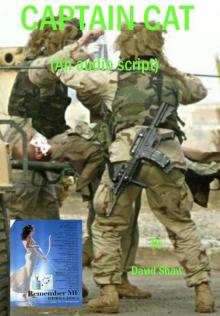- Home
- David Shaw
The Rockets' Red Glare
The Rockets' Red Glare Read online
THE ROCKETS’ RED GLARE
By
David Shaw
Copyright 2010 David Shaw
A few weeks into the war and the Master Gunner of the British Army is a worried man. The Royal Artillery is by far and away the most professional arm of the British Army, but well below establishment in modern guns and it's going to take a long delay before the ordnance factories can catch up on the demand.
One day the MG is lunching with General Pile, the head of the Royal Artillery Anti-Aircraft units, and he mentions his empty gun parks. General Pile reminds the MG that the AA branch is also short of modern guns, and is introducing rockets as a substitute for heavy AA guns. In fact an experimental batch of the new three inch AA rockets have just finished firing trials in Jamaica and the weapon has been passed for service. Might there not be a possibility of using the three inch rocket as an artillery weapon? Rockets can never be as accurate as guns of course, but they're cheap and easy to produce and can carry a heavy payload of explosive.
Intrigued by the idea the MG returns to his office and asks for any intelligence reports on foreign armies which might be developing rocket batteries. The information which comes back is scanty. There are rumours that the Russians are showing some interest in artillery rockets, but there are always rumours about the Russians and never any hard facts. What is known is that the German Army is supposed to be developing rocket projectiles for smoke laying purposes. It's believed these German rockets are spin stabilised, with carefully machined and angled venturi. The rocket gases exhaust through these venturi and spin the projectile to keep it as accurate as possible.
The MG ponders over this report. The British don't have the production capacity to spare to produce the complex German style rotating rockets and fin stabilised rockets are certainly inaccurate. But would it be possible to design a launcher which could give a certain amount of spin to a finned rocket and thereby improve its performance?
The MG orders an effort to be made to produce an artillery field rocket based on the 3" AA rocket. During the winter there are strange and fearful noises from a test range in North Wales and by the spring the "Tulip" is a flourishing weapon. Nobody quite knows why the 3" field rocket was christened Tulip -- probably because it was a hybrid, with a five inch warhead grafted onto a 3" rocket body with shortened and canted fins.
Naturally, the apparatus from which it was fired was called a Tulip Bed. A bed weighed just over a ton, had 32 barrels each 58 inches long, with a pitch of half a turn in the barrel length, the pitch coming from internal rails into which the Tulip's fins fitted.
It was recognized from the beginning that the smoke trails left by the rockets would enable accurate German counter battery fire to be aimed at their positions within minutes of launching. Which meant that the tulip beds would need to shoot and run, or, as the Royal Artillery usually described the tactical doctrine: ‘fire and fuck off .’
Each Tulip Bed launcher was made as mobile as possible by being mounted on a standard Bedford three ton lorry. With the usual canvas cover erected on the lorry and covering the launcher it looked just like any other supply vehicle. A battery establishment is drawn up based on ten Bedfords: four launchers and four re-supply lorries, plus three HQ/liason Humber Snipe wireless vehicles. Two Daimler scout cars are also provided for forward spotting officers. A complete battery could therefore fire 128 Tulips in one salvo and carried 9 complete salvos as immediate reloads.
The Tulip itself weighed sixty seven and a quarter pounds as a complete round, the five inch warhead being twenty nine pounds with a high explosive filling of seven pounds. The rocket motor was eleven pounds of cordite, cruciform in cross section and it burnt for 1.6 seconds. The projectile's maximum velocity was 1100 ft/sec and it was spinning at 660 rotations per minute when it left the launcher.
Of course the major concern to the Master Gunner was the operational capabilities of the Tulip. He was quite pleased with a maximum range of eight thousand yards but the accuracy figures gave him pause. At maximum range half the rockets landed in a strip of land 240 yards long by 240 yards wide. Which wasn't so bad, but what was worrying was where the other fifty per cent of the Tulips might land.
The MG went through the figures again on the back of an envelope. A single salvo of field rockets from a one battery delivered the same high explosive content as a full broadside from two hundred and fifty 4.5 medium field guns. That was quite incredible, but it would be vastly preferable if all this devastation landed on top of the enemy and none of it on British troops. How to control the use of such massive but unpredictable firepower?
The Master Gunner thought he knew the answer. It could best be done by a light aircraft which would be attached to the battery and devoted exclusively to providing the battery commander with the information he needed to use his firepower in the right place and at the right time. In fact, in the MG's opinion, such observation aircraft should be available at all times and on all fronts to carry out spotting duties for all RA batteries. What was needed was for the Army to have its own small air arm, a suggestion which the RAF would certainly fight tooth and nail. However . . .
The MG arranged a test firing of the experimental Tulip battery in front of a group of Very Important People. The battery firing was impressive -- so impressive in fact that one member of the Cabinet had an involuntary bowel movement in his immaculate Saville Row trousers as the rockets began shrieking off. Despite that official orificial hiccup the watchers unanimously agreed that it would be far better if these infernal devices were dropped on and around German heads rather than British ones. It was further agreed that under these special circumstances each Tulip battery could have a light aircraft as a permanent part of its establishment.
The next problem was to find a suitable aircraft for the job. The MG asked for advice and was told that the closest to ideal aircraft for Army liaison and spotting duties was the Fiesler Storch. Unfortunately Britain and Germany were now at war, which rather put the Storch out of the running. And then the Master Gunner received some help on his aircraft problems from a rather unlikely source, His Grace the Duke of Richmond.
In fact the Duke had been a keen pre-war pilot and aircraft enthusiast. Somehow he heard about the Royal Artillery interest in a light aircraft and decided to drop by Horse Guards parade for a chat with the Master Gunner. In a nutshell, he said, he and a friend, a Mr. Edmund Hordern, had in 1936 constructed and flown a light aircraft which might be suitable for what the artillery wanted. It was called the Hordern-Richmond Autoplane, it had flown over three hundred hours with complete success and it was presently flying from the Duke's estate at Goodwood. Would the MG and an experienced pilot care to stop by and take a look at it?
The Master Gunner said he would, and quickly did. The Autoplane was sitting in a hangar with its wings folded back underneath its tail. A common feature of small aircraft in those days to conserve storage space, but useful in the field as it would be easier to hide a folding wing aircraft underneath camouflage netting.
When rolled out into the open and the wings spread, the Autoplane turned out to be a very neat looking low wing twin engined cabin monoplane with wing span of forty two feet and a fixed undercarriage. What was an immediate surprise was that the two engines seemed very diminutive.
The Duke explained that they were American Continental A-40's, each producing forty horsepower. But the total horsepower of eighty horsepower was quite sufficient because the loaded weight of the Autoplane was only 1,700 pounds and it could maintain height quite easily on just one engine. Normal performance was a top speed of 100 mph and a cruising speed of 85 mph. Stall occurred at 35-40 mph, with no adverse wing dropping. Indeed, the Duke assured his visitors, the Autop
lane's handling qualities were delightful. The design was a development of the very successful Klemm line of light aircraft built in Germany.
The cockpit was opened and examined. The pilot and passenger sat side by side with an excellent view in all directions except to the rear. The control column was centrally mounted between the two seats, with an extension on each side to allow the aircraft to be flown from either seat. What raised the examining pilot's eyebrows was the small wheel mounted on each extension.
The Duke explained that the Autoplane had no rudder pedals or bar: the rudder was instead controlled by the wheel on top of each control column. The Duke assured them that there was no problem becoming used to the arrangement, especially as the Autoplane was such a stable and docile aircraft. All flying manoeuvres could be

 The Rockets' Red Glare
The Rockets' Red Glare Captain Cat
Captain Cat